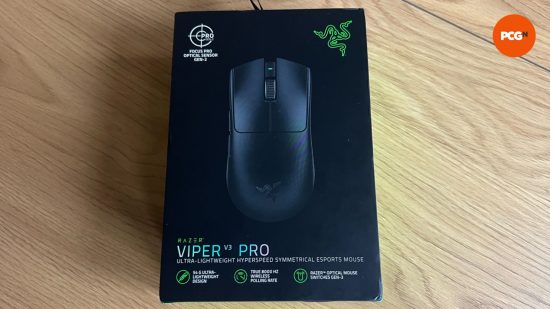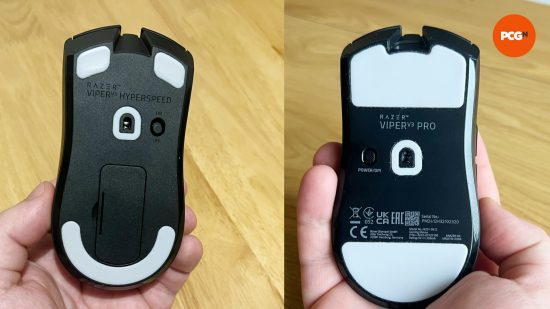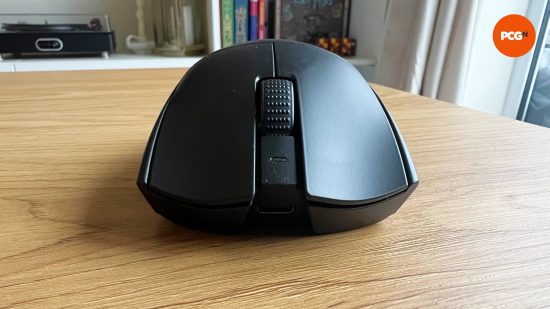Our Verdict
The Razer Viper V3 Pro is one of the best esports mice released not just this year, but possibly ever. Its performance is exceptional and its lightweight, pared-back design is a joy to use in the heat of esports battle. Its price, however, proves to be a tough sell, especially given the 8KHz polling rate doesn’t feel essential and there’s no option to buy this mouse without the expensive dongle needed for that feature.
- Weightless feel
- Symmetrical design
- Large PTFE feet
- 8KHz out of the box
- Great on soft and hard surfaces
- Hidden DPI switch
- Price
- Low battery life at high polling rates
- Can’t buy without Hyperpolling dongle
Razer is targeting ultra-competitive players with its Viper V3 Pro, a gaming mouse that, for all it does well, struggles to put enough clear ground between it and the V3 Hyperspeed, which is almost $100 cheaper. That’s not to say the Viper V3 Pro isn’t an incredible mouse, because it absolutely is, but on this occasion, I would suggest that Razer may have been better off releasing it before the V3 Hyperspeed.
That being said, the Razer Viper V3 Pro is still on balance the best gaming mouse for esports when it comes to raw performance. Unbelievably light and designed around making movement on any surface feel like your hand is floating around your desk, gamers who are serious about improving their response time and gaming at 8KHz polling will find plenty to justify the premium price tag.
Why you can trust our advice ✔ At PCGamesN, our experts spend hours testing hardware and reviewing games and VPNs. We share honest, unbiased opinions to help you buy the best. Find out how we test.
Specs
| Sensor | Razer Focus Pro Gen 2 |
| Battery Life | 95 hours @ 1KHz Polling |
| Max DPI | 35,000 |
| Buttons | 5 |
| Weight | 54g (55g for White model) |

Features
The Razer Viper V3 Pro is an esports gaming mouse with connectivity via Razer Hyperspeed Wireless or USB-C wired connections. We’ve seen quite a few wireless mice include both 2.4GHz wireless and Bluetooth recently – including in the Viper V3 Hyperspeed – but the latter is not present here, which is a shame for those that like to use one mouse for multiple devices, though it’s not a huge factor for a dedicated esports mouse.
More of an issue is that Razer doesn’t offer this mouse without its 8KHz Hyperpolling dongle. This could be bought as an optional extra on some previous Razer mice – for $30 – but here is included by default, adding to this mouse’s high price. For anyone who might have already bought this dongle, it would’ve been nice to have the option to buy this mouse without it, especially as the 8KHz polling kills battery life and isn’t always a feature that can be used on some systems.
Even with the Hyperpolling dongle being the only option, you can choose to run the mouse at lower polling rates. It will run at 1KHz, 2KHz, 4KHz, or 8KHz when using the wireless dongle, and 125Hz, 500Hz, and 1KHz when wired. Yes, despite, Razer offering 8KHz polling over a wired connection on some mice – such as the DeathAdder V3 – it doesn’t offer it here.
There is no RGB on the mouse, which is a common feature of modern esports-focused mice. It helps preserve battery life, minimize weight, and fits in with the idea that no serious player is looking at their mouse while gaming.
Razer packs its 35K Focus Pro optical sensor and new gen-3 optical switches into the Viper V3 Pro. The headline DPI number is of course rather meaningless and mouse sensors have by and large been flawless in real-world use for years now, but Razer’s latest should in theory be one of the best. Meanwhile, those switches should ensure there’s zero latency from the debounce delay normally needed in non-optical switches and they’re also rated for a long 90 million click life.
The 100% PTFE feet are much larger than on many of Razer’s previous mice. You might not notice an immediately smoother glide compared to smaller feet but these should wear much slower and are less likely to dig into softer mouse mats and some people find the larger pads feel more stable than several smaller pads. Included in the box is some grip tape which can be added to the body of the mouse, should the matte feel not be sufficient for you.

Design
One aspect of its gaming mice that Razer generally has no issues with is styling. The company just has a knack for making effortlessly clean designs, and the Viper V3 Pro is no different. However, where the company has previously added RGB and rubber grip pads, for instance, here Razer has stripped back everything that isn’t considered absolutely necessary or fit for purpose.
This includes an accessible DPI switch. These are frequently placed just below the scroll wheel, but in esports mice, they can more commonly be found on the underside of the mouse, as is the case here. I personally prefer to have it in reach as I like to switch between two sensitivity profiles depending on the weapon I am using in games like Warzone and Counter-Strike 2. I have to concede, however, that the general consensus is that the positioning of this button could potentially be an interference and lead to accidental activations, therefore it has been moved to share space with the power button.
Elsewhere, there is a no-thrills approach to the Viper V3 Pro that has to be admired because it results in a very soft and natural feel in my hand, aided by the soft-touch coating given to the mouse (that we can only hope doesn’t wear away quite quickly like so many such coatings). In collaboration with the 54g weight, the V3 Pro floats around both soft and hard surfaces with no effort.
Two features of the Razer Viper V3 Hyperspeed that have carried over into the V3 Pro are the shifted rear hump and pronounced ridges on the left and right click buttons. The hump works to ensure your grip never creeps forward and makes the mouse feel front-heavy while the button ridges massively reduce the risk of slips and misclicks in clutch moments.
You still get the standard two side buttons included on the left-hand side of the mouse, but given the symmetrical design, it would have been nice for Razer to bring back the additional side buttons it had on the Viper Ultimate. There is an argument that this may create some awkward grips or an unusual feel, but we didn’t find this to be the case with the old design, and other mice such as the original Logitech G Pro Wireless and Corsair M75 Wireless nailed this design by making the buttons removable if they’re not being used.

Performance
The Razer Viper V3 Pro is technically unrivaled when it comes to performance. This is down to the combination of the gen-2 Focus Pro 35K optical sensor, gen-3 optical mouse switches, and 8KHz polling. No other mice on the market combine quite such a set of latency-reducing, high-speed tracking features. In practice, the real world impact of this is extremely hard to distinguish but every little helps.
Tracking the Viper V3 around my display was buttery smooth, but we all know that’s not what matters when talking about gaming mice. So, I put the Viper V3 Pro through its paces in Counter-Strike 2 and Valorant to see how it holds up.
I’ve started to lean towards lighter mice when playing these round-based competitive shooters as it results in less hand strain and fatigue over the course of multiple games being played. The Viper V3 Pro’s incredibly light frame was perfect for long sessions and I never found myself needing to flex and adjust my hand between rounds or matches because the comfort level is simply elite.
When it comes to the high polling rate that’s such a selling point of this mouse, having played games at 1KHz, 4KHz, and 8KHz, I could feel a slight uplift in the smoothness of response at 4KHz but the difference was hard to distinguish moving up to 8KHz.
Strangely enough, it was in moments where I am perhaps idly aiming or making the slightest adjustments to my view through the AWP scope that the Viper V3 pro’s high polling rate came through most. It’s so responsive that it almost feels like it’s ready to predict my next move, jumping into action before I feel like I’ve started to respond.
Speaking of AWP play, sniping in both CS and Valorant was as easy as it can ever be thanks to the exceptional sensor and its high acceleration rating. Few modern gaming mice exactly struggle on this front with sensors generally being so good but no matter how quickly you flick and swipe, the Viver V3 Pro isn’t going to suffer from whiplash and leave you with inaccurate tracking.
Ultimately, having a mouse like the Viper V3 Pro removes any possible peripheral barrier to your aim being pixel-perfect. Again, it’s something that’s true of a few rivals, but these top-tier mice being so light and capable really does make them a pleasure to use and something to get excited about.
A single on-board memory profile will let you save your settings and take them with you wherever you play, and the customization options in Razer Synapse are fairly expansive with the option to cycle between up to five DPI profiles, power saving settings, smart tracking/lift tracking distance, and input reassignments for all buttons except the left click.
Battery life
One area where the Viper V3 Pro will struggle to keep up is its battery life. I waxed lyrical about how the V3 Hyperspeed adopted the use of an AA battery and didn’t feel any worse off for it, but here the addition of a rechargeable battery allows for the incredibly lightweight final design.
The trade-off is that the max battery life at 1KHz is 95 hours, which isn’t so bad – it’s on par with other rechargeable wireless gaming mice – but this drops quite severely down to just 17 hours at 8KHz. The lack of Bluetooth also means you miss out on the ability to get an even longer life for those times you might be using the mouse while traveling.
However, you can access battery saving settings in Razer Synapse to make sure you can preserve your battery whenever the Viper V3 Pro isn’t being used. Plus, the charge time is rapid, with a full battery available in less than an hour.
Conclusion
I love the Razer Viper V3 Pro and everything it stands for with its stripped-back, lightweight design and performance that’s turned up to 11, helping you stay competitive in your favorite esports games.
Regardless of my adoration for the Viper V3 Pro, its $159.99 price is hard to swallow. While it sits on par with other premium, feature-laden gaming mice like the Logitech G 502 X Plus and SteelSeries Aerox 9 Wireless, it’s still on the extreme end of the value scale. In particular, there’s a real case for opting instead for the Viper V3 Hyperspeed, with or without the Hyperspeed dongle, though it is a fair bit heavier mouse once you’ve added in an AA battery.
I think it will come down to the level you play your games at. If you’re very good at games like CS2, Valorant, League of Legends, and DOTA 2, then the Viper V3 Pro is worth the outlay. It can’t be ignored that this is a professional bit of gear, fine-tuned for the highest levels of play. But if you enjoy a far more casual and less competitive environment, I recommend looking elsewhere for your next gaming mouse.
Alternatives
Razer Viper V3 Hyperspeed
If price is a point of contention, the little brother of the V3 Pro is more than sufficient when it comes to gaming performance and also improves on the battery life thanks to the use of an AA battery as mentioned above. This does add a considerable 28g to the overall weight though.
The V3 Hyperspeed also isn’t 8KHz compatible without the Hyperspeed Wireless Dongle, which will bump the price up considerably if you’re chasing the highest polling rates possible.
Corsair M75 Wireless
The Corsair M75 Wireless can’t get anywhere near the lofty 8KHz polling rate of the Viper V3 Pro, but it does have a stunning battery life, RGB lighting, and a more accessible and true symmetrical design built with lefties in mind.
